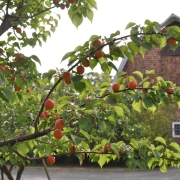 |
Some white tomatoes, grown
years ago |
Two or three people have already asked me, “Are you growing anything special this year?” Each time I had to stop and think: Am I? Then I feel, yes, I should be growing something new each year. Then, on the other hand, I feel, what with the vagaries of the weather and pest problems, that it’s interesting enough just to grow every year what I’ve grown in previous years. Reinforcing that last thought is a quote from Charles Dudley Warner (My Summer in a Garden, 1870): “I have seen gardens which were all experiment, given over to every new thing, and which produced little or nothing to the owners, except the pleasure of expectation.”
I’ve surely paid my dues in the “experiment” department. I’ve grown garden huckleberries, an annual that, cooked with lemon and sugar, is alleged to rival blueberries for pie. False! Garden huckleberries are tasteless. The pie would taste like a lemon-and-sugar pie. I’ve grown white tomatoes, touted as being sweeter than red tomatoes. One taste made me realize how welcome is the refreshing tang of red tomatoes. And then there was celtuce, supposedly combining the leafy qualities of lettuce and crunchy stalk of celery in one plant. Not so! It tasted like bad celery and bad lettuce. Celtuce is essentially a lettuce going to seed, the seedstalk trying to stand-in for celery.
————————————————-
Okay, now that I think about it, I am growing some things that are sort of new this year. Normally I would shy away from planting apricots, even though biting into a tree-ripened apricot — sweet, soft, and rich in flavor — is a heavenly experience. But apricot trees have serious insect and disease problems, their early blossoms usually succumb to late spring frost, and our fluctuating winter temperatures increase disease susceptibility so that the trees die either quickly or slowly.
Still, I couldn’t resist, while perusing Cummins Nursery (www.cumminsnursery.com) website and happening upon the variety Jerseycot, the most reliable apricot for apricot-unfriendly regions of the northeast. Planting an apricot tree may represent a 20 year cycle for me; about 20 years ago I finally gave up and cut down an apricot tree I had planted a few years earlier. (The wood is beautiful and I reincarnated it as a coat rack. I hope this year’s tree sees many productive years before becoming a coat rack also.)
 |
| Apricots, in my future — I hope. |
Another “new” plant for this year is honeyberry (Lonicera edulis), sometimes called edible blue honeysuckle. This is another plant I grew many years ago. It performed poorly because of the poor care I gave it which was mostly because of the poor flavor of the one berry I tasted. But honeyberry is a new fruit, in the same place, development-wise, as the apple might have been 2,000 years ago. New varieties have come down the pike and I’m ready to try these newbies.
A couple of other sort-of-new plants here are artichoke and citrus. The artichokes I planted last summer did nothing except grow leaves. I dug up the two plants, potted them, and have grown them through winter in sunny window. Age and last autumn’s exposure to cool temperature should get me some ‘chokes to eat this year. (Artichokes need a cold spell before they decide to make ‘chokes instead of just leaves.)
New citrus will expand my current collection. I’m deciding between Satsuma mandarin and Clementine which, in either case. will join the rest of the (citrus) family in pots here that winter indoors in sunny windows and summer outdoors in full sun.
————————————————
I’ve gardened for decades, but with a mere 12 years of greenhouse growing under my belt, feel like a novice trying to keep the greenhouse green and productive all winter. The basic routine is to sow salad and cooking greens in late summer and autumn for late autumn, winter, and early spring harvest. Timing is key. Planted too early, some greens go to seed before winter even gets underway; planted too late, short days and cool temperatures don’t allow enough growth for reasonable harvest.
This year, all went smoothly, keeping our salad bowls amply filled right up until a couple of weeks ago. Here, for the record, is some of what worked well:
•Direct sown Green Fortune bok choy, Aug. 30th;
•Direct sown Oregon Giant spinach, Sept. 6th;
•Direct sown Runway arugula; Aug. 28th;
•Direct sown Rhapsody and other lettuces; Aug. 28th.
Lettuce sown in seed flats at the end of December and transplanted out in the greenhouse in mid-February is now big enough to contribute some leaves to salads and, in a few weeks, whole heads. I’ll round out those pickings with recent sowings of spinach, arugula, erba stella, and mustard greens in the greenhouse.
More record-keeping along with fine-tuning sowing times and what varieties to grow will make the greenhouse even more productive in years to come.
————————————————-








Speaking of trying new things that are really supposed to wow you, I don’t suppose you tried the Indigo Rose tomatoes that were in all the catalogs last year? If not, don’t waste your time. Sure, they look really cool, but the flavor is a total dud.
There are a lot of bad tomatoes out there. And some good ones.
Have you tasted “Setoka”? It is currently valued as the best of best tangerines in Japan, among amateur gardeners. I haven’t got it because I have its sister variety “Reikou” which is equally good. Like mineola and seminole, they are both delicious but slightly different. Individual cells of Setoka are firmer, with the result that you feel as if you were eating tiny jellies.
Setoka’s disadvatage used to be its thorns whereas Reikou is thornless. However, thornless Setoka has appeared on the market in the last few years and they may become more popular in the future than Reikou.